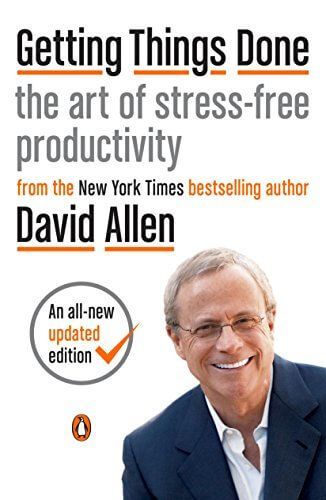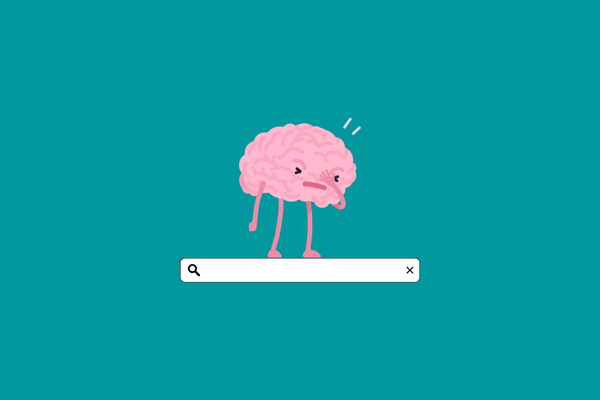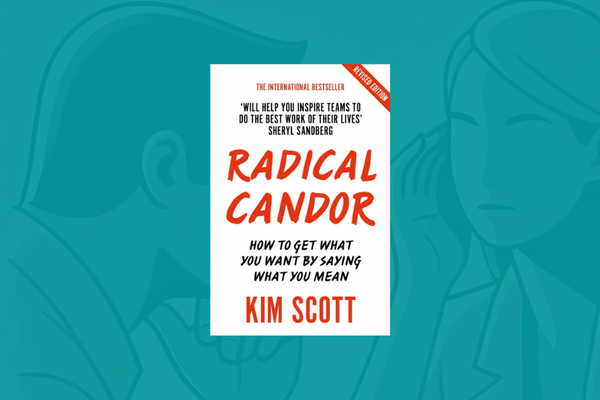Getting Things Done (GTD): Practical Guide for Stress-free Productivity
The GTD method is a productivity system of capturing, organizing and reflecting on tasks, which increases the efficiency of its users while reducing the stress they experience.
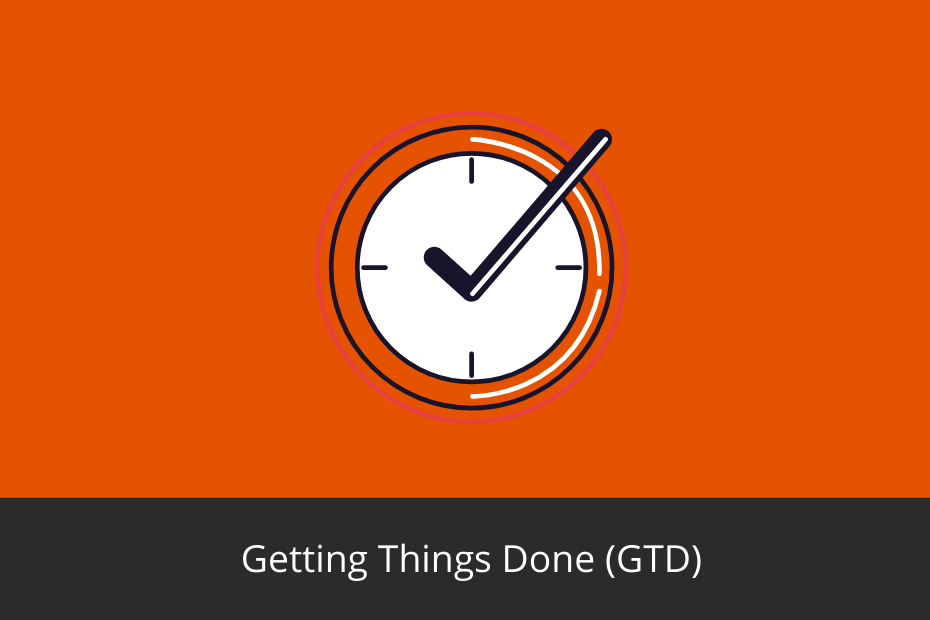
Productivity consultant David Allen developed the GTD methodology, which stands for Getting Things Done. Going beyond time management tips, the tool focuses on "getting things done".
While the fundamentals of the research-based, fine-tuned GTD method have not changed, the updated version of the GTD book also provides answers to issues that have arisen since the first edition in 2001 (the rise of knowledge work, self-management, home office, online tools...).
David Allen's GTD is the bible of the Getting Things Done method.
I share with you the outline of the system described in the book, my favorite tools, and my personal opinion.
Why is the GTD method useful?
Self-organization is essential
For many people, appointment books mean the top of productivity, where they write everything down so they remember everything. Appointment books were a big step towards self-organization, but they were also a response to a transformation in the world of work.
With the rise of automation and machines, there was less and less need for people to do low-value-added work, and then complex, less clear-cut jobs appeared.
Workers on the production line had to cope with new challenges without clear guidance or supervisors to manage their time.
For them, the holy grail was the appointment books.
But even today, the processes that intensified in the 20th century have not stopped, they have only become faster, more global, and made the world of work more competitive.
The GTD method can be seen as an appointment book on steroids.
The antidote to never-ending stress
No magic appointment book can hold more to do than we can get done 24 hours a day. But our commitments are out of touch with reality. We can get more and more done, but we are also taking on more and more tasks in direct proportion.
We are taking on more than we did a few decades ago, and we cannot cope with all this.
The GTD methodology can reduce the stress of our commitments by organizing and prioritizing them, sometimes by refusing to do them, sometimes by postponing them, and by helping us to complete them.
Prepares you for constant change
With increased complexity and more and more tasks, we also have to cope with the fact that most of our plans are on the move.
There is no recipe for success or a sure-fire job.
Today, it is almost unimaginable to do the same job for forty years. In the lucky case, a person's job responsibilities change, in the worse case, their tasks are automated, or market changes force them to seek new challenges.
A safe point in the face of constant change is a system that can support us regardless of our tasks, goals, or vision.
The book on which the GTD method is based was first published more than twenty years ago, but the fundamentals of the system have not changed since then.
"I am pleased to say that everything I wrote about the theory and practice of stress-free productivity in the first edition is still valid today and is likely to remain so in the future." - David Allen
The steps of the GTD method
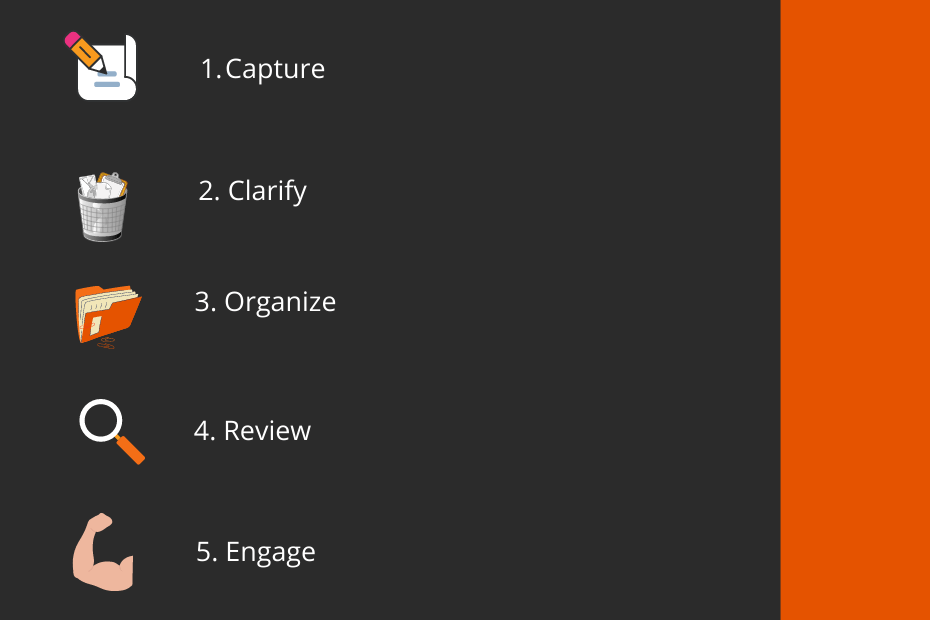
David Allen takes us through five simple steps to stress-free productivity. While they may seem simple when written down (and most of the time they are), that's the beauty of GTD.
It's not an overthought and overcomplicated technique that its creator is trying to sell us, but each step is in the equation for a reason.
And the five pillars of the GTD method are:
- Capture
- Clarify
- Organize
- Review
- Engage
1. Capture
- How many tasks do you have in mind?
- How many will you remember tomorrow and how many will you do?
These are all relevant questions, but there is another unheard of benefit to writing down your tasks and commitments, as well as increasing your efficiency:
- capturing our unfinished business reduces the load on our minds.
Based on Dr. Roy Baumgartner's research, we know that unfinished tasks take up space in our minds. Ideally, we should use our brain's capacity not to memorize independent items on our to-do list, but to trigger thoughts based on pattern recognition.
Writing down our to-do list leaves more room for other thoughts.
While recording to-dos makes sense in itself, without the action that follows, the frustration of producing endless task lists is only frustrating.
Once you've got past the first point and have written down or recorded your commitments in your favorite productivity app, the next step is to decide which of them are worth doing.
2. Clarify
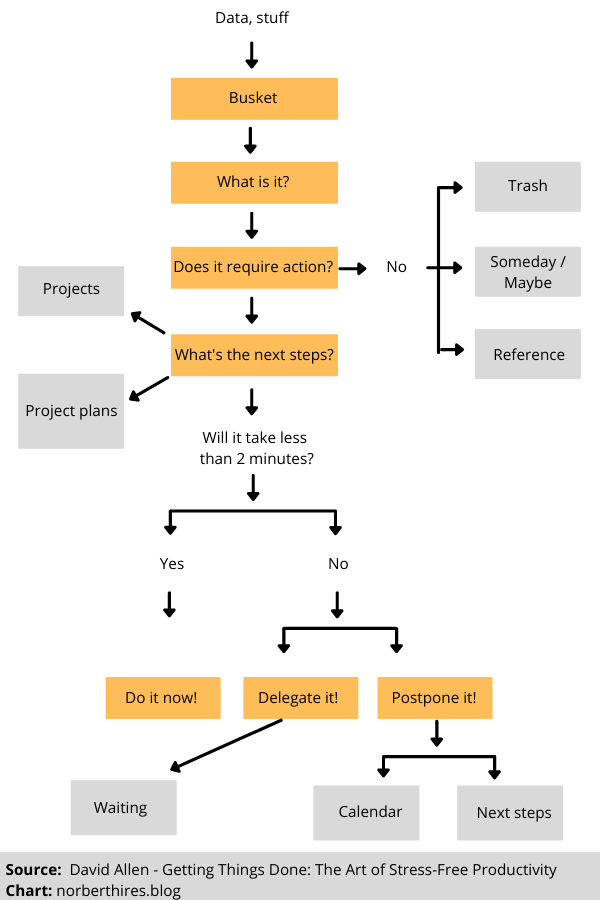
During the clarification phase, we decide what to do with the recorded items.
For items that come into our system (email, business card, invitation) we first need to decide what they are. So the first step is to make sense of the often ambiguous notifications and their counterparts disguised as to-dos.
Is it a to-do?
Although the GTD method has been introduced as a to-do focused system, David Allen sees his method as a way of processing and storing all the incoming information that we encounter in our everyday lives.
There are three further categories of non-tasks:
- Trash: junk mail, information not needed later
- Material to be handled later: items that will fit into a list or a timer folder at some point
- Reference material: items that can be searched for when needed
What's next?
If the fixed item requires action, we again have three options, albeit with a twist.
While still in the clarification phase, we will look at the two-minute rule.
According to the two-minute rule, if an item takes less than two minutes to complete, it should be done immediately. On the one hand, it would take more time to administer than the task itself, and on the other hand, it allows us to focus on tasks of truly meaningful size and importance during the following GTD stages.
In addition to the tasks that take less than two minutes, two other paths are available during the second steps of GTD:
- Get it done! (If it takes less than two minutes.)
- Delegate! (If we are not the best person to do it.)
- Postpone! (Put the task in our system and come back to it later.)
3. Organize
Organizing is the process of associating context with our elements so that we can perform them with as little thinking as possible. Such context can be provided by recording the tools/locations needed to perform a task as a label.
Some tasks require our laptop (making a presentation), others we can only do at home (cleaning the garage), and others that require our phone (booking an appointment). If we make a note of these criteria, we won't have to think about what we can do with our phone in our stolen minutes when we come back to the task list.
In the GTD book, David Allen shares with us several other suggested labels (Things to discuss, Waiting for others...), but the labels are really up to us, we should use distinctions that help us.
The GTD methodology treats lists as the most important element of the classification.
According to David Allen, if you only have a list of 25 to-do items, it is not worth bothering to make additional sub-lists, but most of the time this is not the case.
It is common to have 'projects' that are themselves more than 25 tasks, such as organizing a conference, renovating a house, or introducing new software.
There are three types of project list
- problems (washing machine broken)
- process improvements (introducing a new billing software)
- opportunities for development and creative expression (I want to learn to cook)
Lists bring order to chaos, so David Allen recommends making them in peacetime when there is nothing else to do with them.
In addition to project lists, we can also benefit from making various checklists to automate processes. This could be a record of your workout plan, a to-do list at the end of the year, or a Christmas dinner schedule.
Folders, email, calendar
Our system receives not only tasks but also important information with no clear action to take. We may receive an interesting newsletter in our email inbox or find a useful article on the Internet that requires no action other than reading it.
We may also receive official documents, invoices, and items to keep in our online inbox, which can be used as reference material later on but do not generate any obligation.
As well as maintaining our work, David Allen's method of cleaning up our email accounts, accessing inbox zero, and categorizing items is also a good way to do this.
In addition to mail clients and various to-do apps, GTD encourages us to use our calendar.
Among the to-do items, it is worth moving events with a deadline and accepted invitations to the calendar, so that they are not forgotten and our list is not overloaded with events that do not have extra to-do items.
4. Review
"I spent many years researching this and analyzing my clients' personal systems. In doing so, I realized that the key to the sustainability of the process is the weekly review." - David Allen
The elements of the GTD method that at first seem complicated are difficult to use as a system and benefit from. According to its creator, David Allen, the key difference between those who use the system successfully and those who can not make it is the weekly review.
The weekly review ensures the sustainability of the system and provides lessons that are missed when juggling with labels and to-dos. The Weekly Review is a bird's eye view of the past period, picking up loose ends, acknowledging progress, or even taking note of stumbling blocks and preparing for the week ahead.
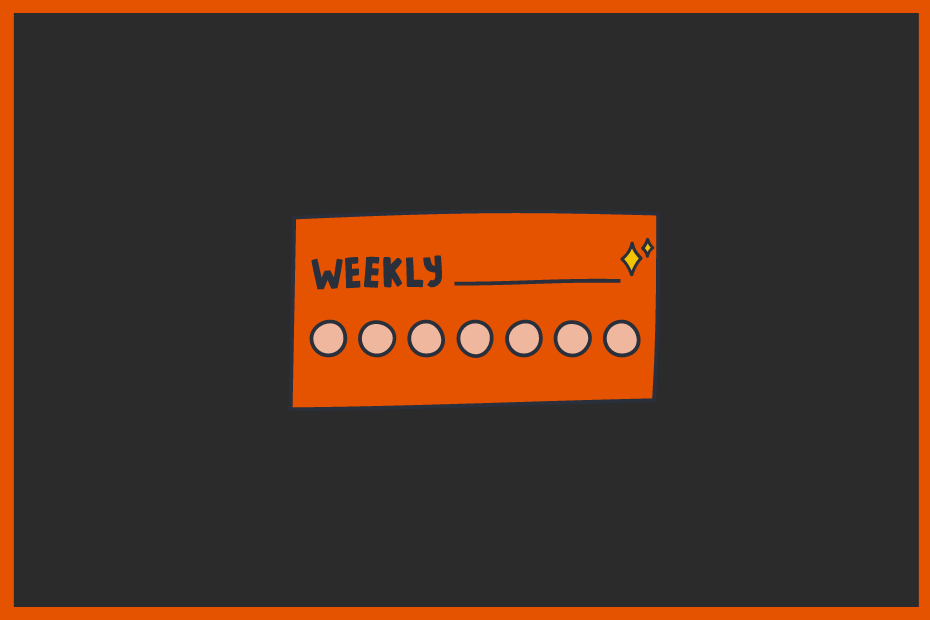
Aspects and questions to consider during the weekly review:
- Are/were the important projects in focus?
- Were we juggling small, unimportant tasks or working on tasks that contribute to larger goals?
- What loose ends remain from the past week?
- What email, commitments, notes have not been entered into the system?
- Let's do a recap, write out every task we can think of!
- Let's review the list of next steps!
- Review our long-term goals and project list!
According to David Allen, it takes at least two years to master the GTD method to a sufficient level. Productivity is a marathon, not a sprint, so it makes sense to increase your likelihood of success with one of the most valuable elements of GTD:
The weekly review.
5 . Engage
We have in hand an organized, labeled list.
What do we do now?
The GTD method uses three models to help you choose the ideal next step:
A model to identify the work to be done at the moment
The four-variable model helps you choose the most appropriate task for the situation, based on the environment, the time available, your energy level, and your priorities.
- Context: what might limit our activities at a given moment? Do we have a computer? Is it a home or office task?
- Time available: when do we need to do something else? Is there time to do something else?
- Available energy
- Priorities: what is more important at the moment?
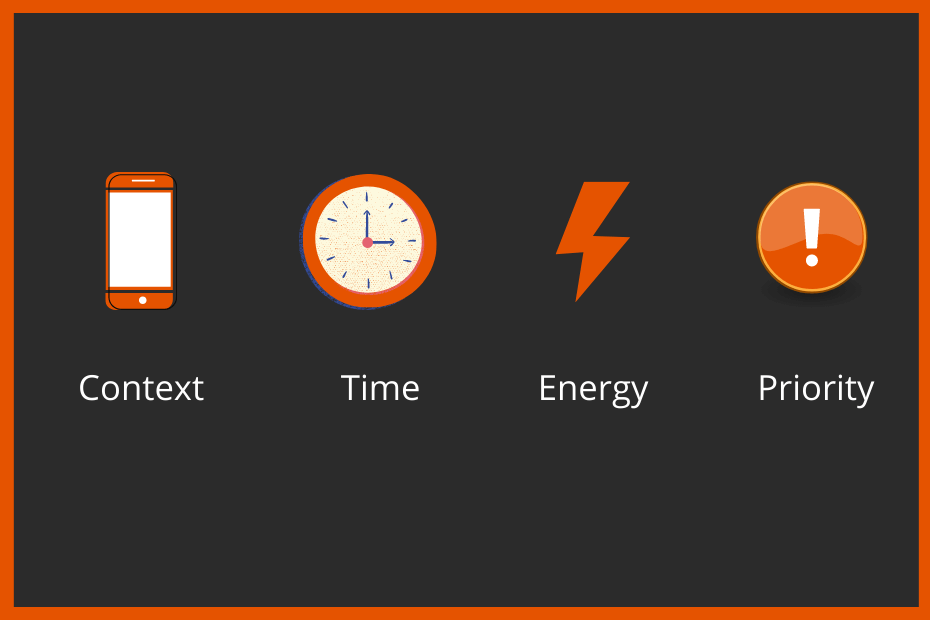
Three types of tasks
The GTD method also offers a crutch based on the type of task.
While it is great to plan ahead using the earlier steps, the creator of the method says that we still prioritize urgent but not important tasks and spend most of our time in the second quarter of the Eisenhower matrix.
A sudden task is exciting, unexpected, and well-defined, unlike the predictable items on our to-do list or the work in progress on our projects. But it is inefficient because it will not move us forward with our real goals, it will only give the appearance of efficiency.
It is therefore worth considering the type of task in the Engage phase:
- We are doing predefined work: following a list of next steps.
- We are doing work in progress: we are doing a task that comes up unexpectedly.
- We define our work: we prioritize and select work based on incoming paperwork.
Six-level model to maintain focus
I also recommend reading the GTD book because it contains tools and self-development exercises that are completely independent of the method and can be used independently of the other elements of the GTD system.
One of these is the six-level model.
GTD goes beyond the day-to-day tasks anyway, but by introducing the six-level model, we can be sure that we are not just ticking boxes at the end of the day, but are making progress towards something important to us.
The six levels outlined in the book:
- Basic level: current tasks
- Horizon 1: current projects
- Horizon 2: focus areas and responsibilities
- Horizon 3: goals - what do we want to achieve in a year or two?
- Horizon 4: vision - where do we want to be in three to five years?
- Horizon 5: mission and principles - why do we or our company need to be here?
Planning
While the steps of the GTD method deal with concrete actions and their implementation (or delteting, delegating, postponing), we need proper planning to make the system work smoothly.
We look for tasks for problems, write project lists for projects, brainstorm.
In the book, David Allen presents and suggests several tools to help us with planning. These include mind maps, flip charts, sketching programs, notepads, and ring binders.
The father of the GTD method identifies over-designing our week as a typical error.
It's worth planning more loosely, according to David Allen, as more work will come in anyway. However, as well as planning more loosely, it is also useful to plan more often to keep track of changes to your system.
My opinion on the GTD method
Although I am at the beginning of my GTD journey in a strict sense, I have been using the different elements of the system described by David Allen for years. Writing down thoughts and actions is nothing new to me, as capturing ideas using the Zettelkasten method has been part of my everyday life for a long time.
For me, the greatest added value was the reflective questions and the tools that could be used out of the context of the book. And by digesting the lists, I started to plan further ahead, finding time and energy for things I hadn't even thought about before.
I can also tell you about the drawbacks of the GTD method.
Writing down tasks and keeping them in mind can go wrong because each task is a promise to yourself. If we do not do it, we can easily lose confidence in ourselves. Several times, I have put aside my Notion charts for using the GTD method and stopped following through on tasks because of such a loss of confidence.
It is dangerous to write down what we want to achieve because we will know exactly what we did not accomplish.
How to get started with GTD?
The most obvious way to learn about the details of the Getting Things Done: The Art of Stress-Free Productivity. Although I had previously read several articles and videos about GTD, I needed the book to be able to look at the system as a whole.
At the same time, David Allen's book was not my life's reading.
The basics are well explained by the author, but half of the book is unnecessary anecdotes, over-complication of details, and listing of person-dependent examples.
I also found the GTD book too paper-centric.
Printing out emails just to file and put in a binder is simply stupidity in my opinion, but I may change my mind about that in time.
Regardless, I recommend reading the book because it is simply the best resource for learning the GTD method.
